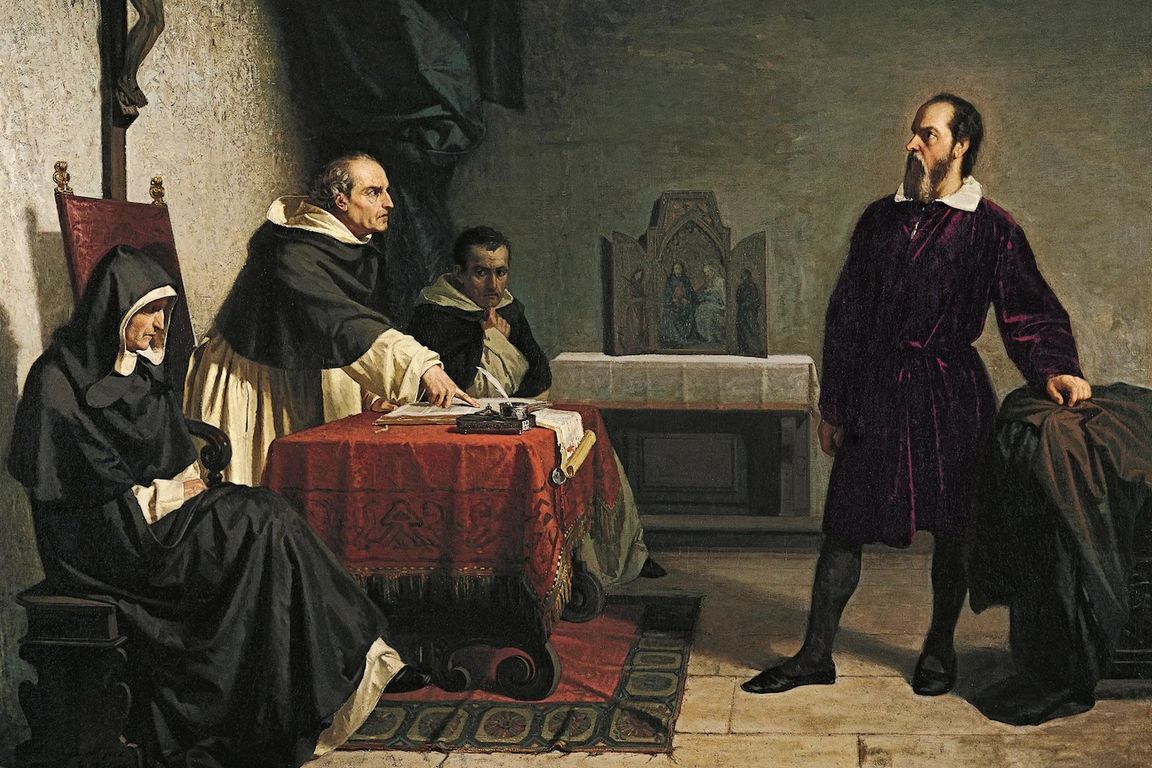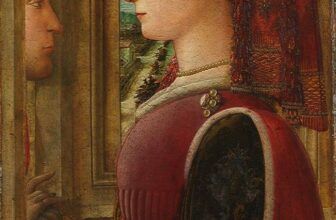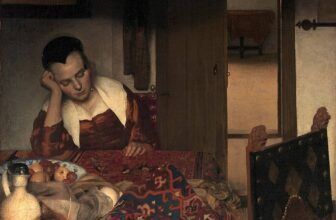
Meaning of Galileo Facing the Roman Inquisition Painting
In the hallowed halls of history, few names resonate as profoundly as Galileo Galilei, the father of modern science. His groundbreaking work in astronomy and physics laid the cornerstone of scientific inquiry, yet his journey was not without peril. One of the most poignant artistic testaments to this journey is “Galileo Facing the Roman Inquisition,” a painting by 19th-century Italian artist Cristiano Banti. This work is more than just a historical depiction, it is a rich tapestry of symbolism, ideology, and emotional gravitas, frozen in oil on canvas.
Let us journey through this masterpiece: analyzing its composition, symbolism, artistic style, historical background, creation, and current legacy.
Cristiano Banti and His Time
Cristiano Banti (1824–1904) was a prominent Italian painter associated with the Macchiaioli, a group of artists often seen as forerunners to the French Impressionists. The Macchiaioli focused on natural light, realism, and emotional depth, reacting against the rigid academic norms of their time. However, Banti’s career evolved in complex ways, and he oscillated between traditional history painting and experimental naturalism.
When Banti painted “Galileo Facing the Roman Inquisition” in 1857, he was stepping into the tradition of history painting, a genre revered for its grandeur and moral weight. Banti selected a pivotal event in Western intellectual history: Galileo Galilei’s trial before the Catholic Church in 1633. It was a moment that symbolized the clash between scientific reason and religious dogma, a subject particularly resonant in post-Enlightenment Europe.
The Painting: A Snapshot of a Historic Confrontation
“Galileo Facing the Roman Inquisition” is a medium-to-large scale oil painting that vividly portrays the aged Galileo as he stands before a tribunal of stern-faced cardinals and inquisitors. The setting is austere and dim, echoing the severity and tension of the moment. The atmosphere is laden with moral and emotional gravity, an artist’s rendering of the moment when knowledge was placed on trial.
In the composition, Galileo, stooped yet dignified, is positioned slightly off-center, emphasizing his isolation. He is dressed in dark scholarly robes, his aged face lit by a subdued light that seems to emanate from an unseen window, perhaps a metaphor for enlightenment itself. Surrounding him are ecclesiastical figures: cardinals, priests, and members of the Roman Inquisition, who observe him with skepticism, superiority, or, in some interpretations, even veiled sympathy.
What the Painting Represents: Science Versus Dogma
At its core, the painting is a visual narrative of intellectual martyrdom. It captures the ideological battle that raged in the 17th century, a conflict between emerging scientific inquiry and the theocratic authority of the Catholic Church.
Galileo’s “heresy” stemmed from his support of Copernican heliocentrism, the idea that the Earth revolves around the Sun. This theory directly contradicted the Church’s geocentric doctrine, which held the Earth as the center of the universe. Despite mounting astronomical evidence, including Galileo’s own telescopic observations, the Church maintained its traditional cosmology, equating dissent with defiance of divine order.
Banti’s painting doesn’t just depict this confrontation, it elevates it into a broader allegory of freedom of thought. Galileo, though physically frail, stands as the embodiment of intellectual resilience. The Church officials, adorned in opulent vestments, represent institutional power and dogmatic rigidity.
Symbolism and Meaning
Banti’s use of symbolism is subtle but potent:
1. Lighting as Enlightenment
Light is used symbolically to emphasize Galileo’s moral and intellectual clarity. While the room is mostly shrouded in shadow, Galileo’s face is illuminated, suggesting the light of reason, even as he is surrounded by darkness. It is an echo of the Enlightenment ideal that truth pierces ignorance, however oppressive the circumstances.
2. Galileo’s Posture
Galileo’s posture is deferential yet assertive. Though bent with age and stress, he does not kneel. This nuanced stance suggests that while he is forced to recant, his spirit is unbroken. His very presence in the tribunal becomes an act of passive resistance.
3. Expression of the Judges
The expressions of the inquisitors vary. Some are stern and accusatory, others contemplative. This variability may suggest that even within the Church, doubt and debate lingered beneath the surface. Not every figure is portrayed as a villain, Banti leaves room for complexity.
4. Absence of a Celestial Globe
Unlike many historical depictions of Galileo, Banti refrains from including visual symbols like telescopes or celestial globes. This artistic choice redirects the viewer’s attention not to Galileo’s discoveries, but to the man himself and the trial of ideas he endured. The omission is powerful: this is not a celebration of science per se, but a meditation on conviction, persecution, and the human cost of truth-seeking.
The Type of Art: A Fusion of Realism and Romanticism
Though painted during Banti’s realist phase, “Galileo Facing the Roman Inquisition” blends Realism with elements of Romanticism.
Realism is evident in the meticulous detail of the faces, the rendering of textiles, and the historically accurate setting.
Romanticism surfaces in the emotional charge and philosophical undertones of the painting. This is not merely a documentary image; it is a moral tableau.
Unlike classical academic paintings that glorified heroic figures in triumphant poses, Banti chose a more introspective, dramatic moment, a quiet climax, where the battlefield is the mind and the weapon is truth.
Italy in the 19th Century
Banti’s Italy in the mid-19th century was in the throes of the Risorgimento, the movement to unify the Italian states into a single nation. The Catholic Church wielded significant power, and its authority was often at odds with the liberal, secular ideals gaining momentum across Europe.
In this context, Galileo became an emblematic figure, a historical martyr for free thought, co-opted by nationalist intellectuals as a symbol of resistance against ecclesiastical oppression. Banti’s painting can be interpreted as part of this broader cultural movement, using the past to speak to the present.
How the Painting Was Created
There is limited direct documentation on the step-by-step process Banti used to create the painting, but based on his known working methods and the techniques of the time, we can infer the following:
Preliminary Sketches – Banti likely began with charcoal or pencil studies, researching 17th-century costumes, architecture, and furniture to ensure historical authenticity.
Live Models – Like many artists of the Macchiaioli school, Banti probably used live models and natural lighting to compose his figures and environment.
Layered Painting – The painting would have been built up in layers, starting with an underpainting to block in forms and values, followed by successive applications of color and detail.
Historical Sources – Banti would have consulted historical texts and portraits of Galileo to ensure accuracy. He may have also referenced earlier depictions of Galileo’s trial to differentiate his own vision.
What Is Happening in the Painting?
The moment depicted is likely during or just before Galileo’s forced recantation, a climactic point in the 1633 trial. The Roman Inquisition found him “vehemently suspect of heresy,” compelling him to abjure, curse, and detest his support for heliocentrism.
Galileo would utter the fabled phrase (perhaps apocryphal) after his recantation: “E pur si muove” – “And yet it moves.” Though the painting does not show him speaking, the emotional weight suggests that the truth remains unchanged, even if temporarily silenced.
Current Location of the Painting
Today, “Galileo Facing the Roman Inquisition” resides in the Palazzo Pitti in Florence, Italy, specifically in the Modern Art Gallery (Galleria d’Arte Moderna). The Palazzo Pitti, once a royal palace, is now home to several important art collections.
Florence, the city of Galileo’s birth and early life, is a fitting place for this painting. It allows viewers to connect with Galileo not only as a scientist but as a cultural and philosophical icon whose legacy lives on.
Impact
Banti’s “Galileo Facing the Roman Inquisition” endures as one of the most evocative portrayals of the tension between faith and reason, individual and institution, science and orthodoxy. It is studied not only in art history classes but also in discussions of scientific ethics, political resistance, and freedom of expression.
In the broader scope of cultural memory, this painting plays a vital role. It reminds us that progress often comes at personal cost. That truth-tellers are not always celebrated in their lifetimes. And that the human spirit, even under duress, is capable of immense dignity.
An Eternal Echo of Defiance
Cristiano Banti’s “Galileo Facing the Roman Inquisition” is not merely a painting, it is a moral inquiry, a historical reckoning, and a quiet anthem to intellectual bravery. In a single frame, Banti captures centuries of philosophical struggle, crystallizing it in the bowed shoulders and luminous eyes of an old man standing against the tide of ignorance.
More than a historical scene, it is a mirror: one that asks us, “What do you do when truth demands a price?”
It is a question that Galileo answered with his life, and that Banti, through his art, asks each generation anew.




